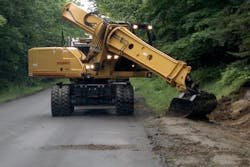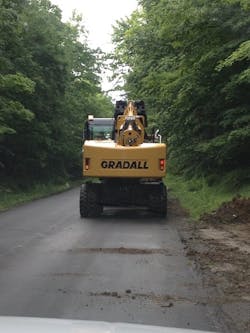Maine DOT uses excavator for ditch clean-out operations
Maintaining highways and the drainage ditches alongside of highways is a major task for the Maine DOT (MDOT). Some 83% of all land in Maine is forested foothills, which are a challenge to maintain even in the best conditions.
When it rains, silt runoff regularly flows down the steep hills on both sides of the roadways, filling drainage ditches with standing water that results in flooding problems in warm weather and icy highways in the winter. The overflow from ditches also makes the adjacent terrain wet and unstable, with soft shoulders or no shoulders at all, meaning there’s no solid foundation for maintenance equipment to work on.
On Route 11, off Route 15 northwest of Bangor, MDOT used a Gradall XL 4300 excavator model with a rubber tire 4x4 wheeled undercarriage, which is able to maneuver and work both on and off paved surfaces. Typically hauled to jobsites on a flatbed trailer, the Gradall can move efficiently on paved surfaces at about 18 mph.
For the Bangor MDOT job, the excavator was equipped with a ditching bucket to clean out ditches along the highway. The primary advantage of the Gradall excavator during the ditch clean-out operation is the telescoping boom. The machine has a low working profile, which allows the telescoping boom to reach out and under tree limbs, signs and other obstacles. The boom tilts 110 degrees in either direction, so it can excavate vegetation, silt, and other material from different angles while maintaining and recreating the proper terrain slope and grade.
Because the entire boom tilts rather than using a boom-end tilting accessory, the XL 4300 does not lose any boom end power on jobs like mass excavation, trenching, spreading rip-rap, demolition, and pavement removal. The tilting boom is able to place buckets, grapples, hammers, and other attachments in the exact position required and from any direction.
The boom is raised, lowered, swings from side to side, digs straight down or tilts using joystick controls integrated into the armrest of the machine.
The telescoping boom allows the machine to stay in one position on the highway, on firm ground, rather than having to maneuver the equipment off-road. This allows for operator safety, and negates any further damage to the roadside terrain and vegetation.
The XL 4300 is designed with a low center of gravity, creating a stable, balanced working profile. The design allows it to work at the front, rear, or either side of the machine without having to lower its optional outriggers or grading blade for extra stability. The excavator also has a counterweight design that has reduced the tail swing by 12 in. from previous models. The advantage on highway jobs is where the machine can work in one lane while traffic flow is maintained in another.
With front axle lockout cylinders, a stable wheeled undercarriage and the low-profile boom design along with the ability to remain stable without outriggers, Gradalls can maneuver with full, heavy bucket loads of material, speeding up the cleanout process.

